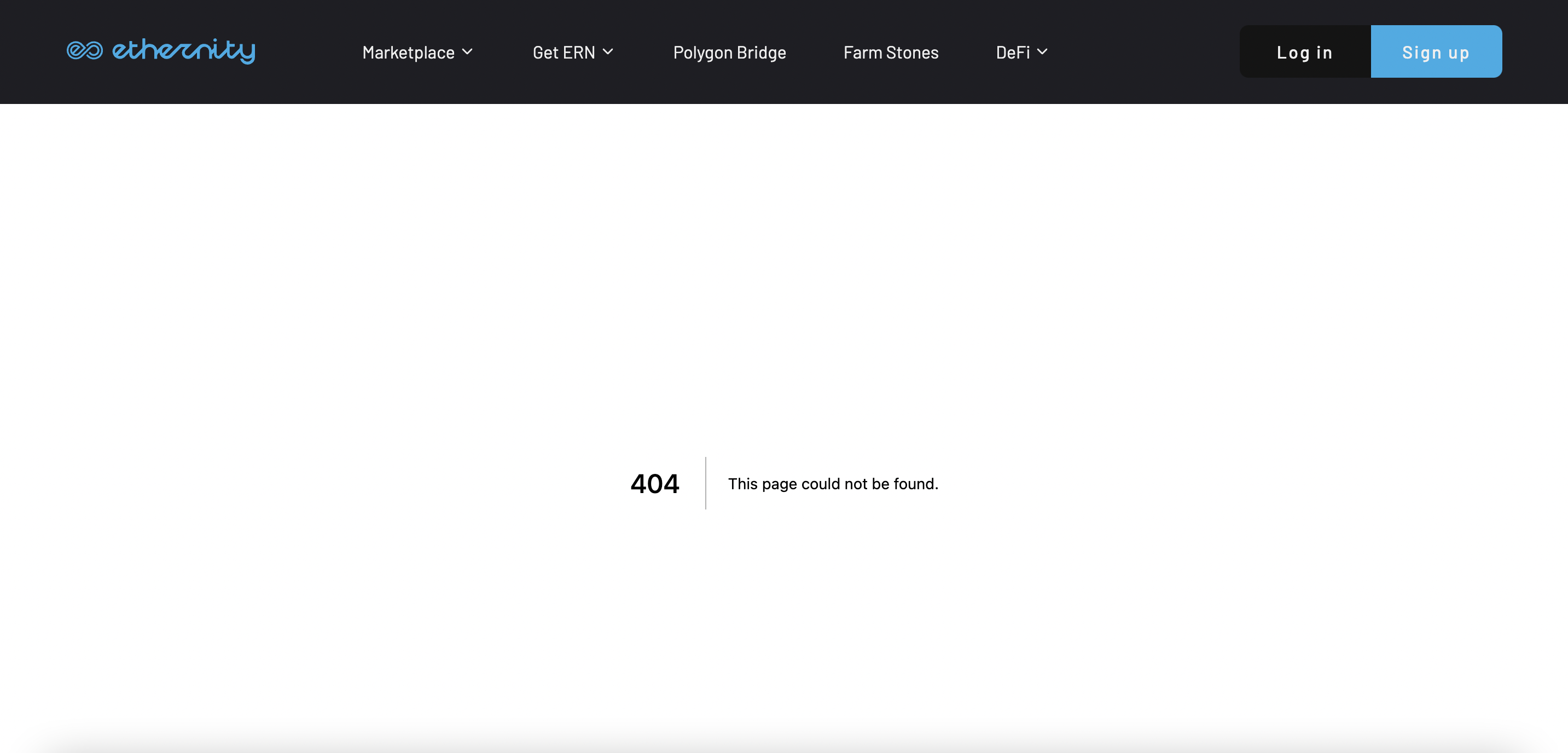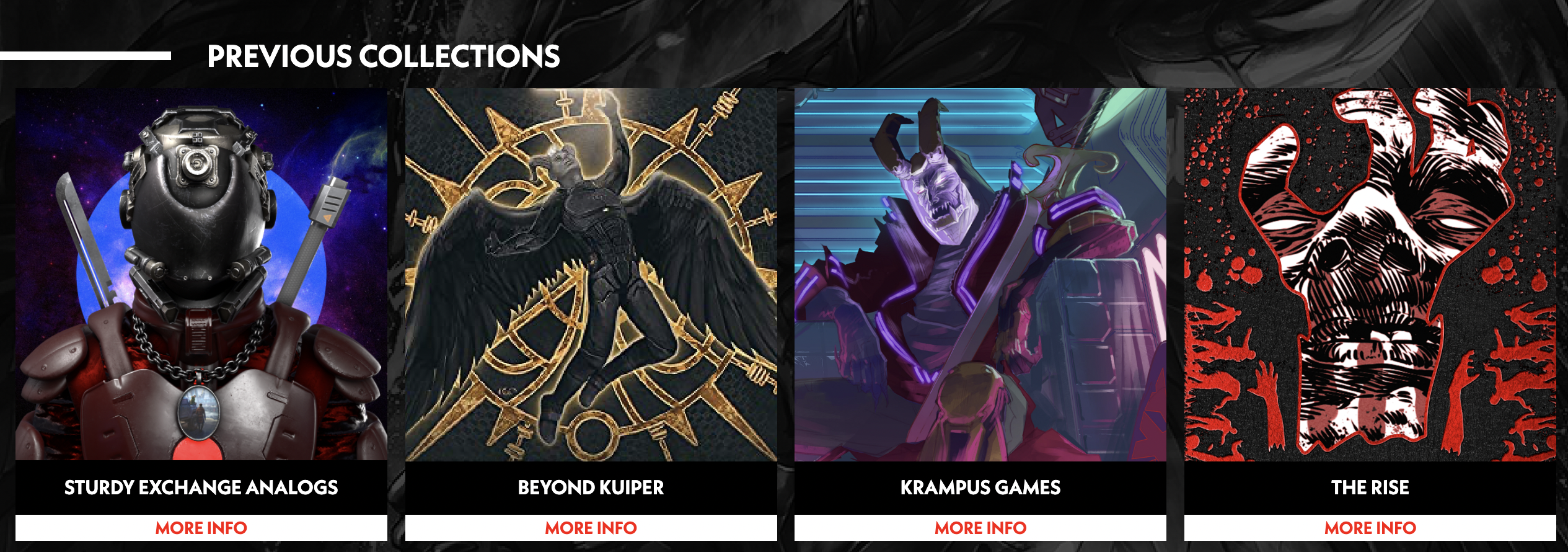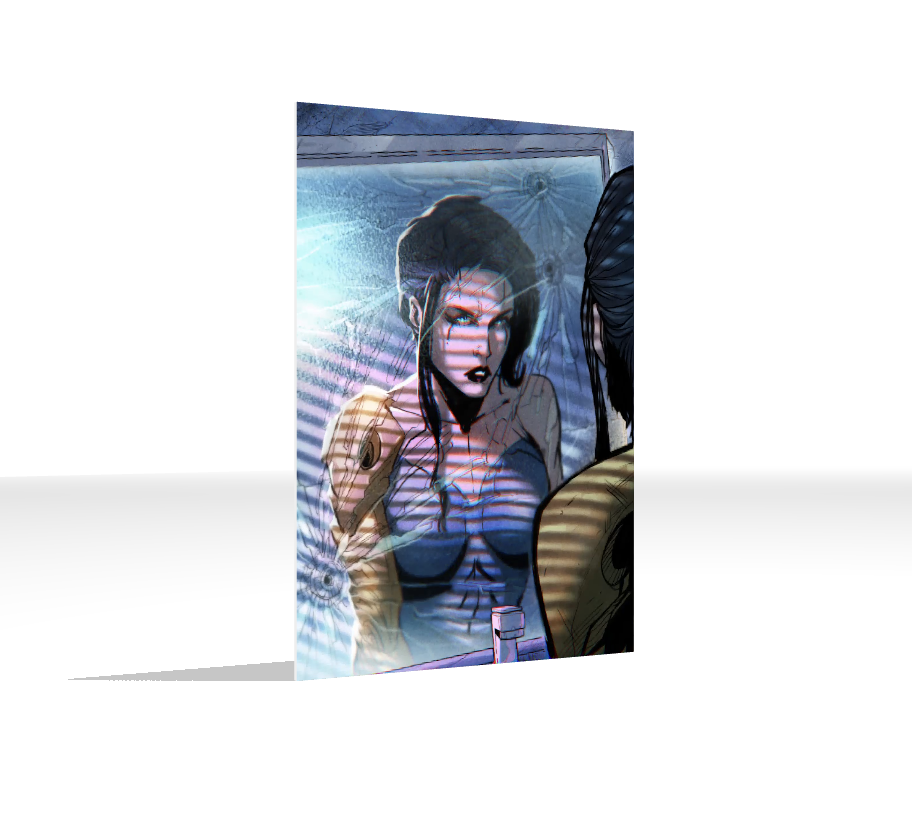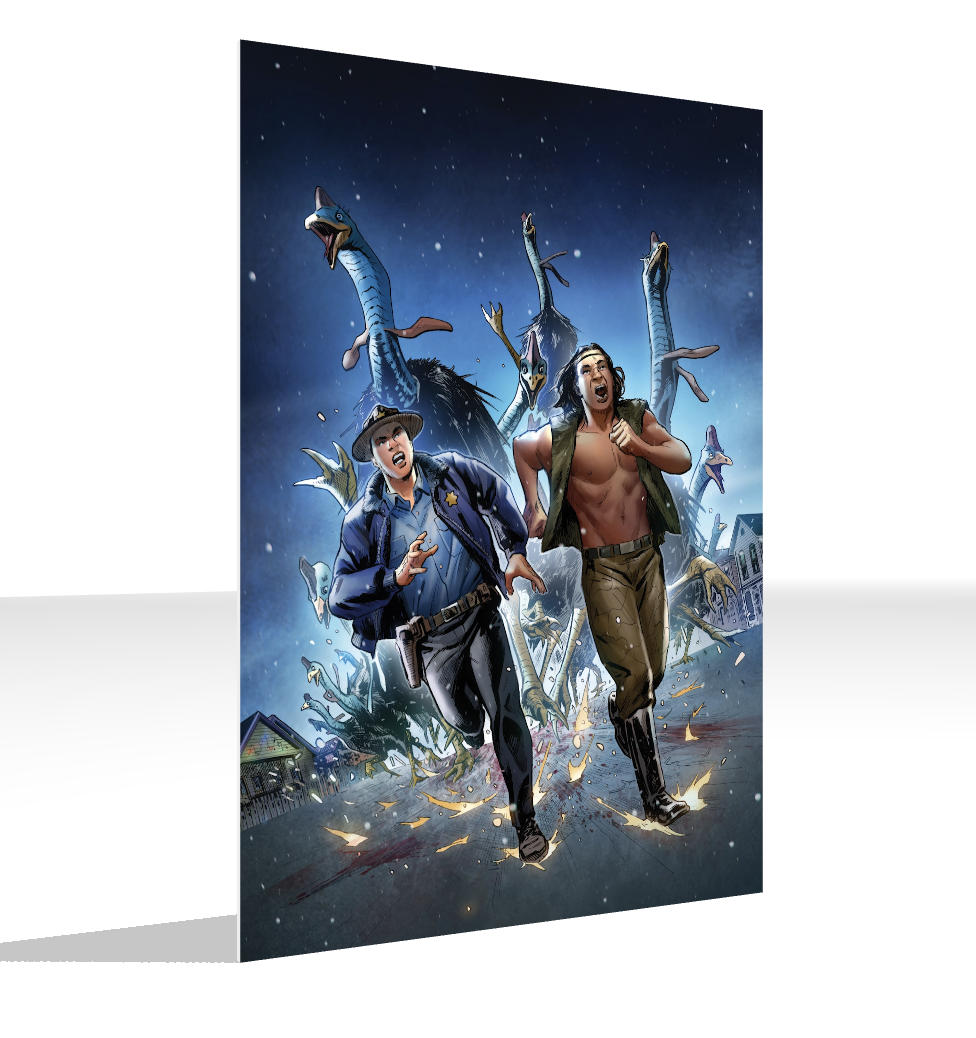
Heavy Metal issue 294, the Industrial Special
Heavy Metal and the fifty thousand NFTs: a new beginning, or the end?
Slick art. Smooth-skin and alloy bikinis. Swords. Mom’s cooking, living rent-free, looking to invest in the next Cthulhu or Hitchhiker’s Guide: Heavy Metal Magazine and NFTs – a match made in fantasy-fi heaven. Maybe a weapon-wielding muscle-hero. Or an animal-faced Athena. Or a coin, minted from the asteroid mines of a distant nebula. Or avatars for the metaverse. Or privileged access. Participatory storytelling. Sanctioned fanzining. Could be epic. Or an epic fail.
In 2021, “Heavy Metal Magazine” built big in the NFT space, and in May 2022, picking through the rubble, it’s hard to know what was meant to happen, what happened, and what’s left.
The magazine, founded in 1977, is emblazoned on the American consciousness: chrome-plated logo and impossible anatomy. There’s a particular US-fuckin-A to the Heavy Metal-style (the magazine originated in France as Metal Hurlant), with its lean into a Bop culture of jeans, finned cars, and brightly fixtured diners. The Metal aesthetic was maybe a Euro upgrade on American pulps of previous decades, Weird Tales Magazine, etc., but that was ok—Americans were shimmying into the age of disco, and the cosmic rag was more fabulous. Forty years later—in 2019, with Billie Eilish a Billboard Woman of the Year, and Playboy Magazine in its death throes—amid a post-woke revaluation of culture, Heavy Metal Magazine looked distinctly vestigial. COVID and our forced entry into the digital new normal, and what’s an old magazine? A brand, an archive, an NFT?
From May 2021 through March 2022, Heavy Metal put out at least eleven NFT campaigns with four NFT partners (Curio, Everscapes/Artefy, Crypto.com, Ethernity) for a total of approximately 49,494 NFTs in a range of multiples/editions. With editions/multiples that weren’t part of any particular campaign, or were included in campaigns not noted here, the number is higher.
Roughing it all out (a timeline):
May 2021: “The Women of Heavy Metal”
In partnership with Curio, “a new universe for fandom,” Heavy Metal launched thirteen NFT editions in multiples of 11 to 250, for a total of approximately 1457 NFTs. The series, minted on the Ethereum blockchain, promised to put “female-driven history & characters at the forefront,” fashioning NFTs from iconic spreads in the magazine, and promising additional “rewards, bonus items and surprises.”
September 2021: “Heavy Metal Cover Collection”
Also with Curio, Heavy Metal released four remastered Heavy Metal Magazine covers. Each cover was broken up into three layers, called “elements,” which were produced in multiples/editions of 300 each. If collected in tandem, the separate layers could be reintegrated, “fused.” The elements, minted on the Ethereum blockchain, were made available through 4800 packs, for a total of 4800 NFT editions (1200 per cover).
September 2021: Heavy Metal Presents “Beyond Kuiper: The Galactic Star Alliance”
In collaboration with Crypto.com, Heavy Metal released a series of NFTs based on the recent novel, “Beyond Kuiper: The Galactic Star Alliance.” The “hard sci-fi” saga was published by Heavy Metal Entertainment, and co-authored by Heavy Metal CEO Matthew Medney and John Connelly, an engineer without a writing background. The collection consisted of 15 NFTs of planets, presumably the ones that make up the Galactic Star Alliance, in editions/multiples ranging from 50 to 225. Five additional editions/multiples of 25 to 111, were listed at the time of the drop as “Individual Collectibles.” Crypto.com NFTs are minted on their own chain, recently rebranded as “Cronos.” Total tally of the drop: 2456.
September 2021: Heavy Metal “Fantasy Launch”
In partnership with Artefy, through their fantasy port Everscapes, Heavy Metal released NFTs of six works by six different artists, in editions/multiples ranging from 100 to 501, for a total of 1371 NFTs editions minted on Polygon, an Ethereum sidechain.
October 2021: George C. Romero, “The Rise”
In a follow-up NFT project with Artefy, Heavy Metal initiated a release of 2000 “crates” each containing eight NFTs. The 50 NFTs of the series—which celebrate George A. Romero’s “Night of the Living Dead”—were released in editions/multiples ranging from 20 to 600. The project was endorsed and supported by Romero’s son, George C. Romero. Total Artefy/Rise: 16,000 NFT editions, minted on Polygon.
In a concurrent project with Crypto.com (minted via Crypto.com), Heavy Metal released a documentary about the origins of “Night of the Living Dead,” in an NFT edition of 10. The documentary was also released in parts 1, 2 and 3, in editions/multiples of 750 each. One more edition of 750 was added to the series in December. Total Crypto.com/Rise: 3010 NFT editions minted via Crypto.com.
October 2021: “The Heavy Metalverse” theme park
Just days after the release of “The Rise,” Heavy Metal launched a character-driven and potentially metaverse-forward campaign with Ethernity. Featuring popular Heavy Metal characters, the series was composed of four 1 of 1 NFTs, the ownership of which afforded access to a Heavy Metal theme park, “The Heavy Metalverse,” which was announced to debut at Art Basel Miami in December. As a Medium profile, Ethernity, summarized:
Revealing the next generation of immersive experiences with characters and settings straight from the Heavy Metal universe — “Heavy Metal Magazine” is the first comic studio to enter the Metaverse. We call it the HEAVY METALVERSE — the first-ever virtual theme park. NFT collectors of the 1 of 1 character avatars of Taarna, Pon Valdur, Adrienne James, and Mortermir get special “metaverse keys” called Metal Keys — these unlock the HEAVY METALVERSE.
In addition to the four 1 of 1s, Ethernity and Heavy Metal released three NFTs in editions/multiples of 70, 100 and 150, and four “Mystery Drops,” which would turn out to be trading cards of the 1 of 1s, in editions/multiples of 600. Of the 2400 Mystery Drops, 24 (the 1%) would receive full access to The Heavy Metalverse. The 2720 NFT editions were minted on Ethereum.
November 2021: Heavy Metal “Future World”
Returning to Artefy and Everscapes, Heavy Metal released 100 editions/multiples of a single NFT, “Future World,” which was minted on Polygon and described as “licensed cinemagraphic art.”
December 2021: Heavy Metal “Krampus Games”
In a Crypto.com release (with some design from Artefy), Heavy Metal gamified a 5200 pack drop. Each pack would reveal three NFTs; the “over ten” NFT editions/multiples were released in variants; for example, the “Taarna’s Street Cred” Air Jordans was released in three colors—“20 lucky winners” would draw “three ‘Taarna’s Street Cred (Red)’ in a pack and be lucky enough to own a pair of Taarna shoes [irl] identical to the NFT.” Or, “30 lucky winners” would receive Cold Dead War Skateboard Decks, irl. Etc. Total: 15,600 NFT editions minted on Crypto.com.
December 2021: “Heavy MetalMas”
In a release with Artefy nearly simultaneous to the “Krampus Games” drop, Heavy Metal released 12 Christmas-themed NFTs in editions/multiples of 40, minted on Polygon, for a total of 480 NFT editions.
February 2022: “Writing With the Legends”
In a Crypto.com series, Heavy Metal released 8888 packs, each of which would contain one of nine medallions, which granted their owners various participation in the writing of one to five storylines to be developed and produced in some capacity by Heavy Metal. The medallions were minted on Crypto.com in editions of 1,900 to 75.
February 2022: “A Very Metal Valentine”
In a Valentine-themed drop with Everscape and Artefy, Heavy Metal released five NFTs in editions/multiples of 100. Total: 500 NFT editions minted on Polygon.
Hmm, that’s a lot of NFTs. And the bigger story of all those NFTs in so little time might well be bottomless, but, anyway, what was the outcome? In a January 2022 piece, “’Heavy Metal’ Gets Its Mojo Back,” “Publisher’s Weekly” relayed that the 2019 sale of Heavy Metal left its new publisher facing the pandemic and massive drop offs in newsstand sales, which only a revitalization of content, serialization, and web infrastructure could save. NFTs, mentioned glancingly in the article, were part of the ongoing reboot. (The piece was authored by Rob Salkowitz, who in 2020 had covered Heavy Metal in Forbes, and was a facilitator in the Heavy Metal/Curio NFT drops of 2021.)
Like the NFT campaigns themselves, which were inadequately announced (in some places the publicity trail seems to have been intentionally obfuscated), the results of the Heavy Metal drops are diffuse—spread across platforms—and difficult to appraise. While crypto and NFTs are often described as indelible (bound to the blockchain), in this scenario, the corresponding web history/provenance is seemingly vanishing before our eyes. Looking at the known quantities, on Curio, “The Woman of Heavy Metal,” resembles a success: sold out. But on OpenSea, the editions show almost no activity. Little to no trading, with no baseline set. Not even on the #1s. Only five of the 1457 appear to be owned by users other than the “curio-platform.” Of these five, there are three users who have set higher prices on their fairly random edition #s. As of this writing, of the 4800 packs of the “Heavy Metal Cover Collection,” also through Curio, 2921 are still for sale. On OpenSea, there has been little activity aside from three outlier users who have set higher prices (one of the covers is a #2 fully assembled from its elements).
The “Individual Collectibles,” issued by Heavy Metal/Crypto.com at the same time as the “Beyond Kuiper” NFTs, seem to have fared better, with some owners asking for higher prices (possibly ludicrously) and #1s at asking prices of around $2000. Eighty to ninety percent of the owners haven’t set prices; but they’re open to offers. As in the Curio release, there’s little to no trade activity. The fate of the Kuiper packs themselves is harder to surmise. Crypto.com doesn’t link them to their markets on the site, but a search of each edition echoes the results of previous releases: not very much activity and a few pie-in-the-sky asking prices, with #1s generally higher. The base price set with the initial drop might be holding: $40.
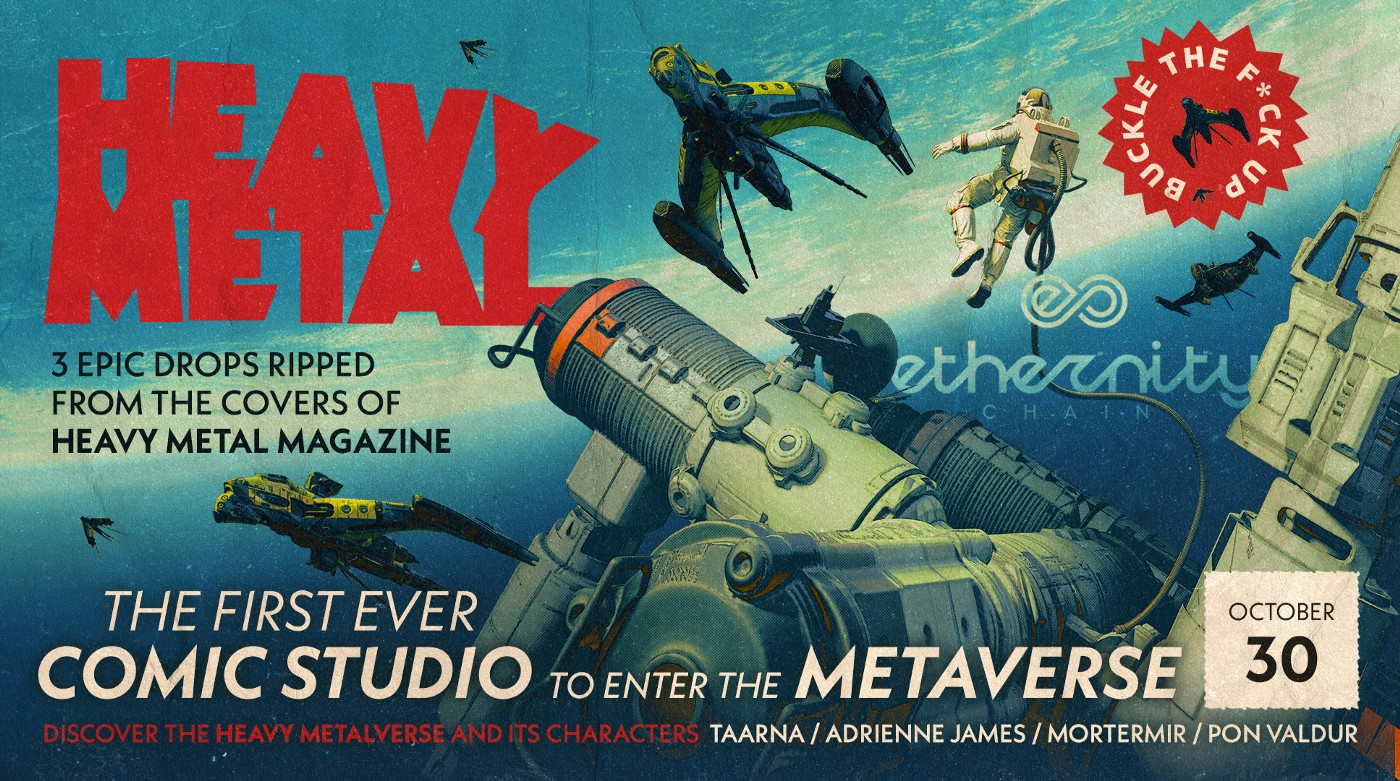
The Heavy MetalVerse published by Ethernity Chain
The Artefy/Everscapes “Fantasy” drop is sold out on the native website, while on OpenSea again, a few I‘m-a-dreamer asking prices, but mostly crickets. The Rise collection on Crypto.com has depreciated to below its floor price, and five months later many of the editions are still for sale. Likewise on Artefy, NFT crates for Rise remain on sale (although the NFTs previews are not presently visible on the site, and do not load in up-to-date versions of Chrome and Firefox); on OpenSea, the tale is familiar—a few optimists, and otherwise flatlined.
The shift to Ethernity for the “The Heavy Metalverse” didn’t alter the trend. And without belaboring the numbers, “Future World,” “Krampus Games,” “Heavy MetalMas,” “Writing with the Legends,” and “A Very Metal Valentine” evidence market stasis, downward prices, a few wide-eyed sellers, and unenthusiasm. But if this second group of drops doesn’t look overly successful, that impression is bolstered by the lack of follow through on the promised utility of the NFTs. In the case of the Metalverse: Well, the Metalverse never happened. (Ethernity and Heavy Metal did not respond to repeated inquiries about the Metalverse. On behalf of Art Basel, FITZ & CO confirmed that Heavy Metal was not a participating exhibitor at Art Basel, Miami, 2021; if the Metalverse was released in Miami in December 2021, it was off site—and there’s no trace of it now.) In “Writing with the Legends,” the disaffection of fans elicited assurances from Heavy Metal that exciting surprises were in the works. Those exciting surprises turned out to be a not-very-useful discount code. Another shortfall: the “Writing with the Legends” medallions were 3D motion, yes, but also glitchy and pixelated (not in a good way). If Heavy Metal readers expected the magazine to get one thing right, that would be the art. Yet, threaded throughout the drops is the theme of broken links and stuff that just doesn’t quite work: at Heavy Metal’s “NFT Central,” for example, the link for “Future World” goes nowhere, redirecting to the home page for Artefy.
Brokenness isn’t a characteristic exclusive to Heavy Metal’s NFT endeavors. As of this writing, a warning on the Heavy Metal website tells visitors—white text on a red color block—that if you try to order a magazine (or have tried in the last few months), you shouldn’t expect it to arrive on any known timeline:
SHIPPING NOTICE: THERE MAY BE A DELAY IN SHIPPING YOUR ORDER AS WE HAVE JUST MOVED TO A NEW SHIPPING WAREHOUSE. PLEASE BE PATIENT WITH US WHILE WE GET EVERYTHING UP AND RUNNING AGAIN!
If you linger on the page, you might also notice that while we’re into March, there’s no March issue of Heavy Metal. Scroll down for the Media Kit, and you’ll find one dated to 2020. Click it, and you’ll arrive at a dropbox link for a deleted file. Call Heavy Metal’s phone number at the Rockville Center Long Island address, and you’ll hear a recorded message: The number you have reached is out of service. Call their office in Easthampton, Massachusetts. Uh, out of service. (In requests for press contacts or comment, Heavy Metal did not respond to Twitter DMs or emails.) While there have been a few 2021/22 media hits for Heavy Metal (as linked above in Publisher’s Weekly, or in Yahoo, for example), and the Heavy Metal NFTs have been variously announced on Medium, a larger press response to Heavy Metal’s foray into NFTs is notably absent—as is, perhaps, a larger press strategy.
Take “Beyond Kuiper.” The release suffered not only from bizarre bios and portraits, but also suspect claims: Matthew Medney, co-author of “Beyond Kuiper” and the CEO of Heavy Metal, for example, is described as a #1 Amazon bestseller, but we don’t know of what. The “bestseller rankings” of “Beyond Kuiper,” at the time of this writing, don’t reflect that status. The “Beyond Kuiper” NFT series was also announced as Heavy Metal’s debut in the NFT space, which it wasn’t.
Maybe “Beyond Kuiper” is part of the getting back of mojo alluded to in Publisher’s Weekly. Twenty-two books have been released by Heavy Metal Entertainment since May 2021, with at least seven more coming in 2022; the titles are distributed through Simon & Schuster. The pivot into publishing bodes well for the Heavy Metal imprimatur; Heavy Metal has a rich list of characters and storylines, and with solid distribution, a real chance of moving units. Maybe the NFTs were part of a publishing strategy. Big book buying crowd in crypto? What is the narrative?
From a speculative point of view, the progression of the blockchains used to mint the Heavy Metal NFTs presents a hypothesis. Minting NFTs on Ethereum is currently the most expensive process—the most accepted and dependable as well, and probably the lowest risk in terms of investment. Heavy Metal’s initial NFTs were put out on the Ethereum blockchain—to a fair outlay of capital, which may not have returned the investment.
The move to less expensive blockchains, such as Polygon and Crypto.com, was a logical next step: maybe to recoup some investment, maybe to make continued production of NFTs sustainable. Polygon is a sidechain of Ethereum with a bridge between the two, so it’s fairly exchangeable in a decentralized financial ecosystem. As a layer 2 solution, Polygon may sacrifice some scalability and safety, but those added risks are offset by the low environmental impact and price. Cronos, the crypto.com blockchain, has a somewhat similar profile; the difference being that Cronos is native to the Crypto.com site, and doesn’t, at the moment, have much exchangeability. Cronos is most useful, and in most cases only useful, on Crypto.com. Crypto.com NFTs stay on Crypto.com, and Crypto.com only supports NFTs that were minted on Crypto.com. With Cronos, Crypto.com is also working on a bridge to the main Ethereum network. With that bridge, Cronos could move beyond its origin as a rewards and fees token for a single website. Like Polygon, Cronos could appreciate: Crypto.com has a huge user base and currency, environmentally low impact, is out there, and the company is looking after it (via buy backs). That said, the reliance of Cronos on Crypto.com isn’t very decentralized, and its infrastructure leaves room for safety concerns. Matt Damon? The Super Bowl? Yes. The value of Cronos jumped 20% in December. But it was down 30% by March.
That problem of centralized “decentralized finance” isn’t exclusive to Cronos. With all these new blockchains, the question is commonplace: When is a blockchain a blockchain with some software/website-like qualities, and when is a blockchain a software/website with some blockchain-like qualities? Moreover, when are you investing in a blockchain, and when are you investing in data in an FTP file? As the risk goes up, so too, often, does the potential for gain.
Was Heavy Metal’s increasingly massive output of NFTs a way to chase losses, increase revenue, or cover operating expenses? The annual revenue of Heavy Metal is estimated from 0 to 2 million to 5 million to 57 million (Grojo, the source of the latter estimate, warns “We do sometimes use data, insights and news coming directly from the companies listed.”) Flooding the market with cheap NFTs seems like a sure way to cannibalize your fans and subscriber base, and Heavy Metal’s Better Business Bureau rating is indeed an F, but Crypto.com clocks Heavy Metal’s volume traded at 1.2 million. The statistical methodology for tabulating that number is unknown. (Crypto.com did not respond to an inquiry requesting clarification.) But a lot of NFTs do enter a state dormancy after their initial sale. Could it be that the torpor of the Heavy Metal NFTs isn’t overly significant?
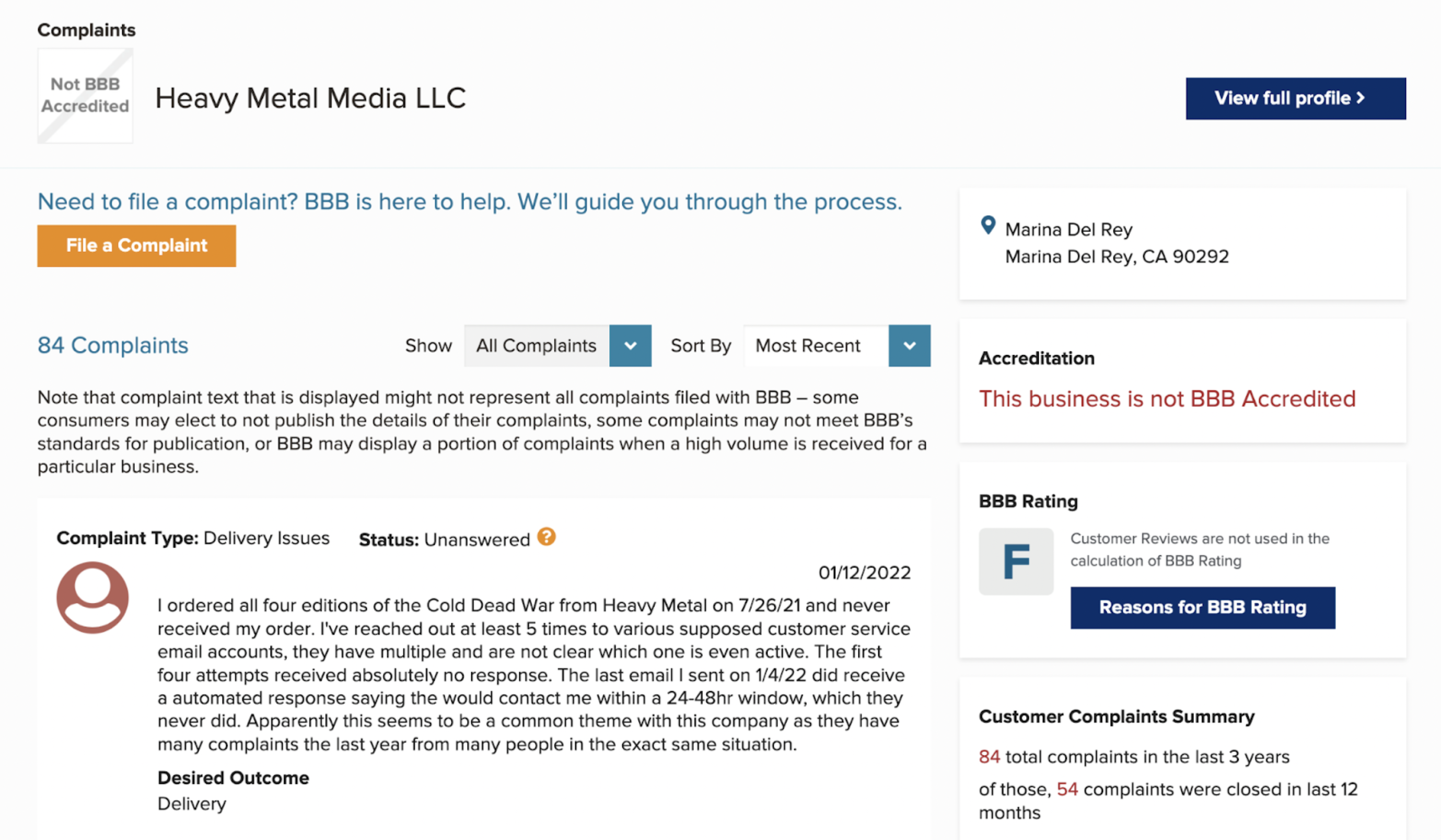
An unnamed, insider source assessed Heavy Metal’s NFT forays in a larger context. “They had more success than a lot of people,” said the source, who emphasized a preliminary success:
“The first drop, with Curio, sold out, like fast…You could probably do the math and see what the topline numbers were—to a company like Heavy Metal that’s a lot of money…It’s like when you sit down at the blackjack table, or at the roulette wheel, and you hit the first one, you feel like you can’t lose.” With later releases, the company sought a broader view of the market, and with an increased cohort of partners, some of the drops were “directly competitive” with themselves, which negatively influenced sales and resulted in a “regression to the mean.”
David Erwin, who was announced in March 2020 as the new publisher and “chief creative overlord” of Heavy Metal, granted a last minute interview to discuss the company’s exploration of the NFT space. Erwin described himself as a 50% stakeholder (alongside CEO Matthew Medney, who did not respond to multiple requests for comment). Erwin, as a longtime DC creative director, sees the Heavy Metal brand as an important contender in a changing science-fiction, horror, and fantasy landscape, with the potential to compete with and parallel the superhero oeuvres of recent years. Erwin, citing the European origins of the magazine, described an increasingly global endeavor and aesthetic. “Heavy Metal should be uncomfortable at times,” he said, “the content and outlook should sometimes be challenging.”
But Erwin’s compelling characterization isn’t the forward face of the brand. In response to a sometimes heated thread on Heavy Metal’s Facebook page concerning the magazine’s failure to deliver subscriber issues, CEO Matthew Medney pointed to “supply chain issues,” and a “third party” who had “failed to fulfill their contractual agreement and obligations to our customers.” Sigh. That, too. Could be. Or should we finally acknowledge that this is a picture of bustedness? And what does that mean? An investment opportunity? There are so many aspects of NFTs to get excited about—in collectibles, in fine art, in finance, even in government and individual freedoms. Maybe the answer here is to pick up a Taarna Card NFT and sell it on the bounce. Or, maybe go hunt down the latest hardcopy. Who knows? A last issue might also be collectible.
“It was a gold rush last year,” said Erwin, “NFTs are still trying to find themselves. We’ve had hits and misses. That’s the nature of where we are…Every new platform has growing pains, but Heavy Metal is a platform that’s not going to go away.”

John Reed is the author of numerous books including A Still Small Voice (Delacorte Press/Delta), The Whole (Simon & Schuster /Pocket/MTV Books), the SPD bestseller, Snowball's Chance (Roof Books/Melville House), and All The World's A Grave: A New Play By William Shakespeare (Penguin Books/Plume). His work has been published in (selected) Artnet, the Brooklyn Rail,Tin House, Paper Magazine, Artforum, Hyperallergic, Bomb Magazine, Art in America, the PEN Poetry Series, the Los Angeles Times, the Believer, the Rumpus, the Daily Beast, Gawker, Slate, the Paris Review, the Times Literary Supplement, the Wall Street Journal, Electric Literature, Vice, The New York Times, and Harpers.
Art

Curated Conversations: ALIENQUEEN
SuperRare Labs Senior Curator An interviews ALIENQUEEN about psychedelics, death, and her journey in the NFT space.
Tech


Out of the Vault and onto the Chain: the Evolving Nature of Provenance
SuperRare editor Oli Scialdone considers the social experience of provenance and its relationship with community in the Web3 space.
Curators' Choice



Curated Conversations: ALIENQUEEN
SuperRare Labs Senior Curator An interviews ALIENQUEEN about psychedelics, death, and her journey in the NFT space.

